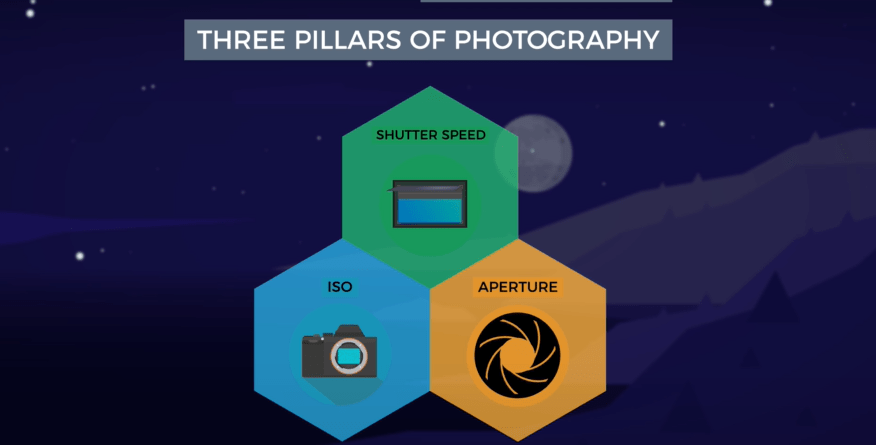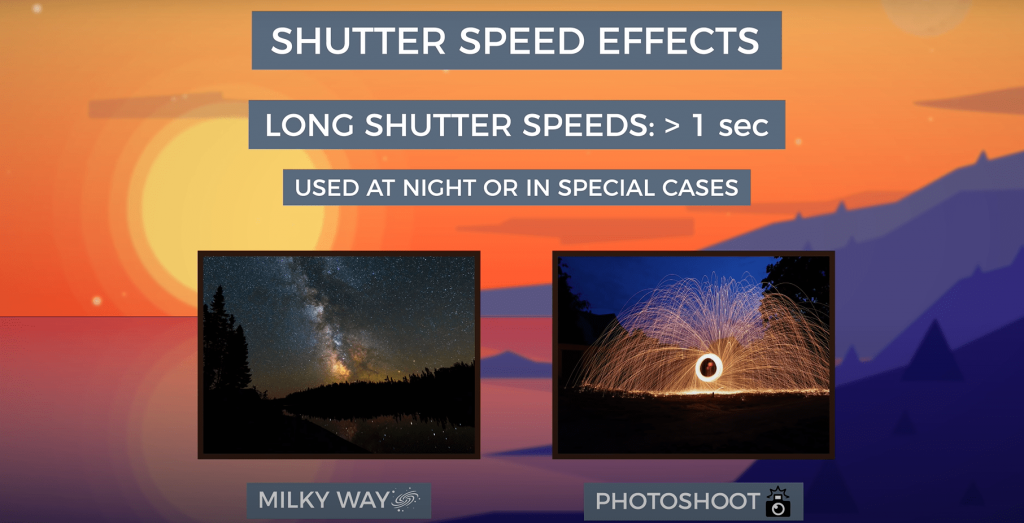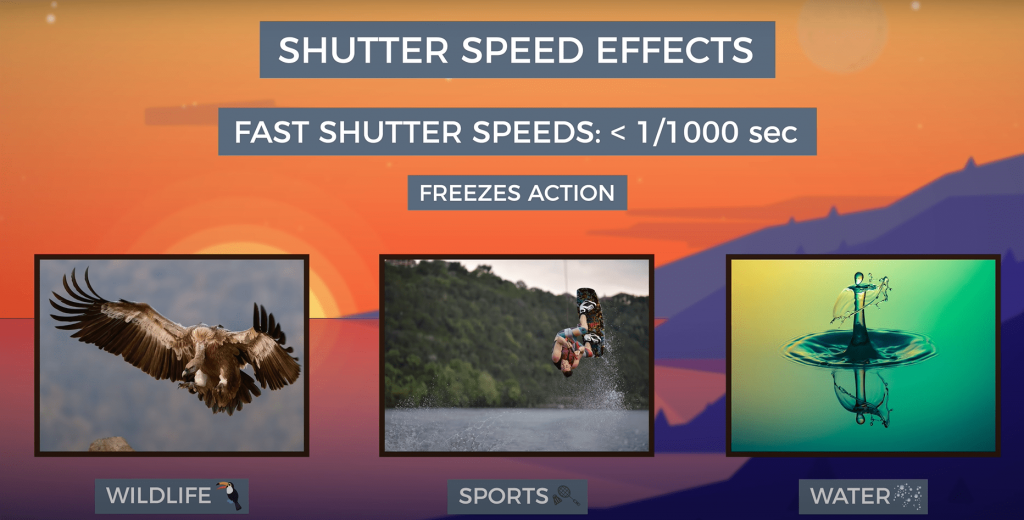What is shutter speed? In this article, we’ll explore how shutter speed works, as well as its different uses in photography.
Photography is an art form that captures stunning images and tells a story. The shutter speed of your camera plays an important role in how the photos will ultimately look, much like your camera’s other settings, such as ISO and Aperture.
Shutter speed is the amount of time your camera’s shutter remains open to allow light into the sensor, so it’s important to understand how it works and how it affects the photos you take.
This article will explore shutter speed and its role in photography so that you can take your photos to the next level.
The Basics Of Shutter Speed
Shutter speed is one of the three main settings controlling exposure when photographing. The other two are ISO and aperture.

Shutter speed refers to how quickly or slowly your camera’s shutter opens and closes again after taking a photo.
A fast shutter speed means that a very short amount of time will be captured by the sensor, while a slower shutter speed allows more light into the sensor over an extended period.
Shutter speed is measured in fractions of a second and can range from as low as 1/4000th of a second to several minutes. A fast shutter speed, such as 1/500th, will freeze an object’s motion and capture the image sharply, while a slower shutter speed, such as 1 second or longer, will blur any movement within the frame.
How Does Shutter Speed Affect An Image?
A slower shutter speed will result in a longer exposure and allow more light to enter the camera, leading to brighter images with softer details. This technique is often used for creating soft backgrounds or silky water effects. Slower shutter speeds can also create motion blur when capturing moving subjects such as people or cars, adding an interesting creative element to your images.
On the other hand, a faster shutter speed will result in a shorter exposure and less light entering the camera, leading to darker images with more defined details. This technique is often used to capture fast-moving objects such as sports or wildlife and freeze their motion in time. Faster shutter speeds can also help prevent camera shake from blurting your image, making them ideal for shooting in low light conditions.
In the end, shutter speed has a noticeable impact on your photographs and gives you the creative freedom to capture different kinds of images with various effects. Experimenting with different shutter speeds can help you create visually interesting and unique photos that stand out from the crowd.
Fast vs. Slow Shutter Speeds
The two most common types of shutter speeds are fast and slow. Fast shutter speeds are used for sharp images with minimal motion blur. This is useful for capturing moving subjects like sports or wildlife in detail. A fast shutter speed also helps prevent overexposure in scenes with strong lightings, such as landscapes with the sun in the frame. It typically ranges from 1/500th of a second to 1/8000th of a second on most cameras.
In contrast, slow shutter speeds are used to blur motion or to capture light trails. This type of speed is ideal for low-light photography, where more light needs to be gathered by the camera’s sensor. Slow shutter speeds also allow you to capture beautiful star trails, light streaks, and long exposures like waterfalls or waves. They typically range from around 1/30th of a second to 30 seconds on most cameras.
In conclusion, fast and slow shutter speeds have unique uses in photography that can create vastly different images. Knowing when and how to use both will give you greater creative control over your photographs. So experiment with different settings, find out what works best for you, and enjoy the results!

Key Considerations for Selecting The Right Shutter Speed
Once you’ve decided on your desired shutter speed, there are a few important considerations to keep in mind when selecting the best one for the given situation. Depending on the type of shot you are trying to capture, the following factors should be taken into account:
1. Motion Blur:
Motion blur can create an interesting effect when shooting fast-moving objects, such as athletes in action or cars driving by. A slower shutter speed will create more motion blur, while a faster shutter speed will freeze the motion resulting in a sharper image.
2. ISO Settings:
The higher your ISO settings, the less light is needed to produce an ideal exposure and thus allowing you to select a faster shutter speed without introducing too much noise in your photo.
3. Aperture:
When shooting with a wide aperture, you will need to select a faster shutter speed to ensure enough light can reach the sensor and create an ideal exposure. On the other hand, when using a smaller aperture, you can use a slower shutter speed without overexposing your images.
4. Lighting Conditions:
If you’re shooting outdoors during daylight hours, then it’s likely that fast shutter speeds won’t be necessary as there is plenty of natural light available. However, selecting a faster shutter speed might be required to prevent underexposure and blurriness due to camera shake if you are shooting during dusk or at night.
By keeping these four guidelines in mind, you can select the perfect shutter speed for any given situation and ensure that your images are perfectly exposed.
Tips for Using Shutter Speed in Different Types of Photography
Landscape Photography
For landscape photography, it’s best to use a slow shutter speed. This will allow the camera to capture more light and create beautiful, detailed images of your subject. A good rule of thumb is to set your shutter speed no higher than 1/60th of a second.
Action Photography
When photographing action shots, it’s important to use a fast shutter speed. This will freeze movement, allowing you to capture sharp images without motion blur. A good rule of thumb is to set your shutter speed no lower than 1/1000th of a second.
Low Light Photography
It can be difficult to get a good image when shooting in low light conditions without using higher shutter speeds. Use a shutter speed of 1/125th or faster, depending on the situation.
Portrait Photography
For portrait photography, it’s best to use a moderate shutter speed. This will allow you to freeze the subject while still allowing some motion blur in the background which can add depth and texture to your images. A good rule of thumb is to set your shutter speed between 1/125th and 1/200th of a second.
Using Shutter Speed Creatively
Using shutter speed creatively can create unique effects with your photos, whether it’s freezing a moment in time or blurring something that is moving quickly. When shooting sports, for example, using a fast shutter speed (1/2000th) allows you to freeze the action and capture sharp images of athletes in their peak moments.

Using a slower shutter speed (1/4th) can blur the motion of water or clouds in the sky, creating an ethereal effect. In low-light situations, you may need a slower shutter speed to allow more light into the sensor to get a properly exposed photo.
Understanding how shutter speed works and exploring its creative possibilities will help you capture stunning images that uniquely tell your story. With practice, you’ll be able to master this essential tool and take your photography skills to the next level!
FAQ’S: Frequently Asked Questions
What Do Different Shutter Speeds Mean for My Photos?
Generally speaking, faster shutter speeds mean sharper images with less motion blur, while slower shutter speeds can add an intentional blur effect to your photos. Fast shutter speeds are great for capturing movement or freezing an action shot, while slow shutters support creative expression in your photographs.
What Is the Best Shutter Speed to Use?
The best shutter speed to use depends on the type of image you’re trying to capture and the amount of light present. In general, faster shutter speeds work well in areas with plenty of light, while slow shutter speeds are better suited for low-light situations. Experimenting with different settings can help you become more familiar with how these settings affect your photos and find an ideal combination for any shooting situation.
Are There Any Tips for Using Shutter Speed Effectively?
To get the most out of your shutter speed adjustments, practice using manual mode so that you can adjust each setting yourself. You should also consider the movement you want to capture and adjust your shutter accordingly. If you’re shooting a still image, start with a faster shutter speed; if you’re aiming for an artistic blur effect, opt for a slower one.
Are There Any Tips For Combining Shutter Speed Settings With Other Camera Settings?
When combining shutter speed with other camera settings, such as ISO or aperture, it’s important to consider how each setting will affect your image. For instance, you may need to adjust the ISO if a slower shutter requires more light. Adjusting your aperture can also help increase or decrease the amount of light reaching your camera’s sensor. Experimenting with different combinations of settings can help you find a creative look unique to you and enhance your photos in exciting ways.
What Are Some Common Mistakes When Using Shutter Speed?
One common mistake is using too slow a shutter speed in bright lighting conditions, resulting in an overexposed photo. It’s also important to remember that fast shutter speeds require more light than slower ones; if there isn’t enough available for the faster setting, you’ll end up with an underexposed image. To avoid any issues, adjust your settings based on the light available and the type of shot you’re aiming for.
Conclusion: So, What is Shutter Speed in photography, actually?
Now that you understand the basics of shutter speed, you’re ready to take your photography skills to the next level. Shutter speed is crucial in photography and can make all the difference between stunning photos and blurry, unappealing shots. With practice and experimentation, you’ll be able to master this important skill and develop your signature style.
Remember: Every photograph has its own story — use shutter speed to tell yours! Experiment with different settings, angles, and perspectives, and let your creativity shine through your work. Whether it’s landscapes or portraits, sports or nature scenes, explore what shutter speed can do for your images. With these tips in mind, you’ll be able to master shutter speed and create amazing photos that you’ll be proud to show off.
